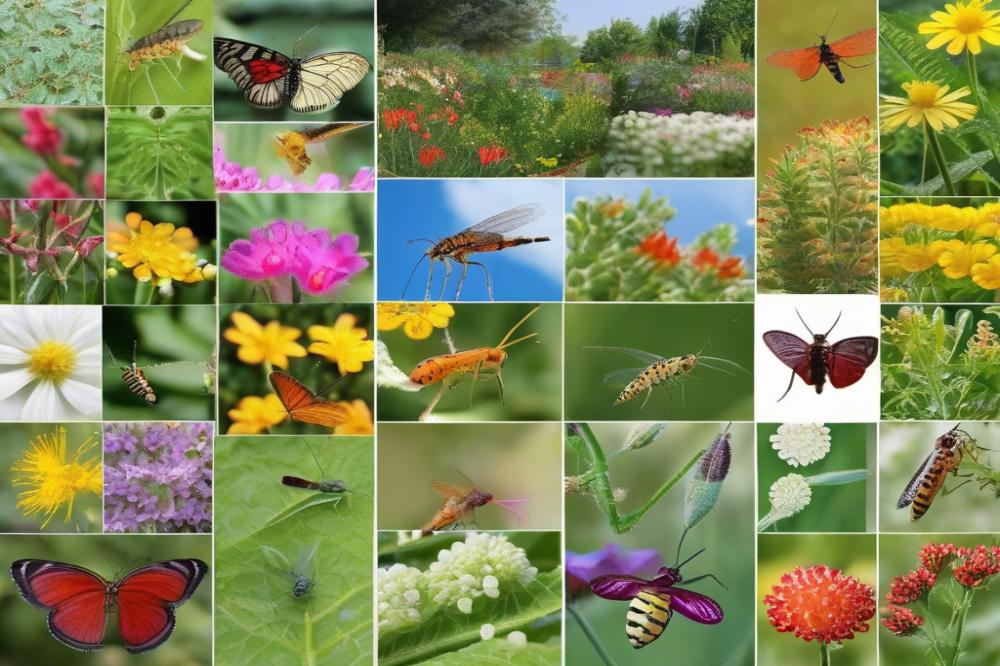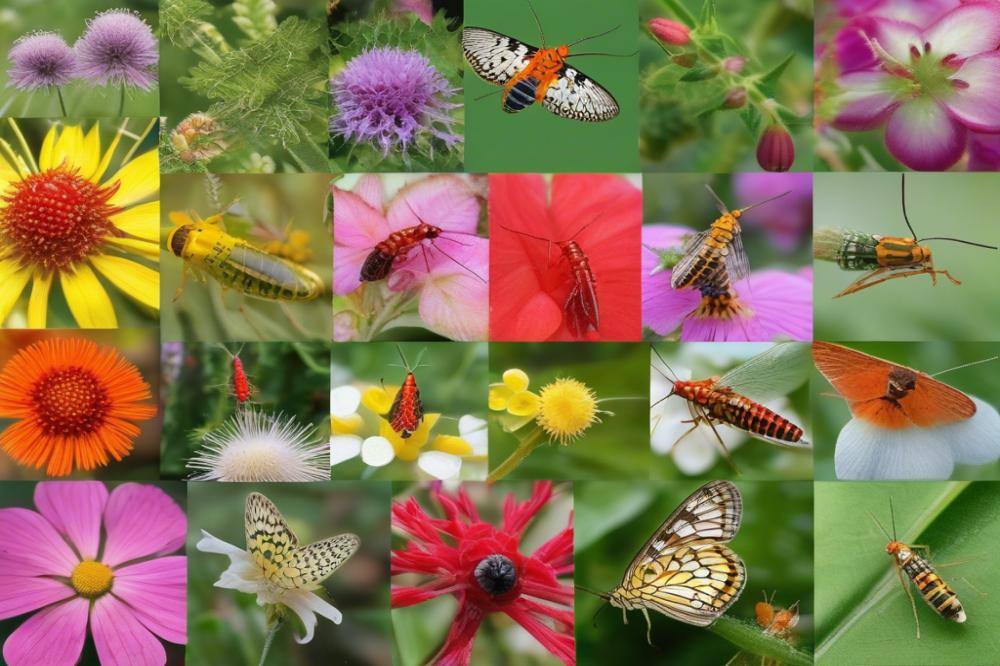The Role of lacewings in pest management
Understanding the role of lacewings offers insight into their importance for pest management in gardens. These insects are natural pest predators, playing a vital part in controlling populations of harmful organisms. common garden pests, such as aphids, can damage plants, leading to decreased crop yields. Effective strategies are necessary to combat these nuisances. This is where the concept of biological control shines.
Many gardeners seek methods that do not rely on harsh chemicals. Instead, they look for alternatives that promote environmental sustainability. integrated pest management blends various techniques to manage pests while minimizing risks. This approach often includes the use of beneficial insects, which support a healthier ecosystem, allowing plants to thrive.
Recognizing the significance of pest suppression is essential for any sustainable farming practice. Green lacewings, in particular, are champion insectivores, known for their voracious appetite for pests like aphids. By encouraging this natural predator, organic farming systems can effectively reduce pest populations without chemical interventions. Such practices not only protect crops but also preserve the delicate balance of nature.
Ultimately, when we embrace these ecological strategies, we foster healthier gardens and landscapes for the future. Effective pest control doesn’t have to rely solely on human intervention. Instead, giving nature a helping hand can lead to a prosperous coexistence for all living things.
Understanding Lacewings


Green lacewings are among the most recognized beneficial insects. These delicate creatures have translucent wings and soft bodies. Their appearance is often described as charming due to their bright green color. Adults typically measure between 1/2 inch to 3/4 inch in length. They are known for their graceful flight and distinctiveness, often fluttering around gardens in search of food and mates.
The life cycle of these insects is fascinating and plays a vital role in their ability to manage pests. It begins when the female lays her eggs on the undersides of leaves. Each egg is tiny and often attached to a stalk to protect it from predators. Once the eggs hatch, the larvae emerge. These larvae are voracious feeders and are particularly effective at aphid control. Each larva can consume over 200 aphids in a week, making them excellent pest predators in any garden.
Habitat preferences for green lacewings include areas with abundant vegetation. They thrive in gardens that feature a mix of flowers, herbs, and shrubs. These habitats provide shelter and plenty of food. Additionally, they prefer environments with low pesticide use. Avoiding chemical sprays allows beneficial insects to flourish, promoting biological control methods. Observing how these lacewings interact with the ecosystem reveals their importance in integrated pest management.
When comparing green lacewings with other beneficial insects, their unique contributions become clear. Ladybugs, another well-known pest predator, share similar roles in pest suppression but target different prey. While ladybugs are famous for their appetite for aphids, lacewing larvae expand the range of garden pest management by feeding on various insects. This diversity in feeding habits enhances overall ecosystem health, contributing to environmental sustainability.
Organic farming practices greatly benefit from the presence of lacewings. By relying on natural predators to manage garden pests, farmers can reduce dependency on synthetic chemicals. This not only benefits the crops but also promotes healthier soil and biodiversity. Every gardener should consider these beneficial insects essential allies in creating a balanced ecosystem.
Lacewings as Pest Predators


In the world of gardening, certain insects play a vital role in maintaining balance. Among them, green lacewings stand out as effective pest predators. They are particularly known for targeting common garden pests, especially aphids. Aphids can create significant issues for plants, sucking out vital nutrients. This is where lacewing larvae become essential allies for gardeners.
Lacewing larvae are voracious feeders. They consume various soft-bodied pests that threaten plant health. Along with aphids, they also hunt down mealybugs, spider mites, and whiteflies. These larvae have jaw-like structures that allow them to grasp their prey effectively. By feeding on these pests, they contribute to pest suppression. This natural form of pest control is an important aspect of integrated pest management and biological control.
The predatory behavior of lacewing larvae is fascinating. They actively seek out their prey, often using a stealthy approach. Once a pest is found, they quickly pounce, often leaving behind a clean area where harmful insects once thrived. This targeted approach helps to maintain a healthy garden ecosystem. It is especially beneficial for those practicing organic farming, where chemical pesticides are avoided. Relying on such beneficial insects not only protects plants but also promotes environmental sustainability.
Gardeners can encourage lacewing populations by planting specific flowers like cosmos or dill. These plants attract adult lacewings, leading to a higher chance of larvae in the garden. This symbiotic relationship highlights the interconnectedness of nature. By incorporating lacewings into pest management strategies, gardeners can achieve effective aphid control and protect their plants naturally.
Using lacewing larvae in gardens offers a sustainable solution to combat garden pests. Their role as pest predators is straightforward yet crucial. They are a fine example of how nature can aid in gardening efforts. Encouraging these beneficial insects means fewer pests without relying on harmful chemicals.
Lacewings in Biological Control


In the realm of biological control, certain insects play crucial roles in managing garden pests. One such group includes lacewings, known for their effectiveness in aphid control. These beneficial insects act as natural pest predators, feeding on soft-bodied insects and reducing their populations without the use of harmful chemicals.
When compared to other biological control agents, lacewings stand out in specific scenarios. Ladybugs are another popular choice and are especially effective against aphids. However, lacewings can consume a broader range of pests, including mites and thrips. Parasitic wasps are also valuable in pest management but operate differently. They lay eggs inside host insects, while lacewings actively hunt and feed on their prey. Each agent offers unique advantages, depending on the type of pest and the environment.
The integration of lacewings into integrated pest management plans is essential for achieving long-term success. They contribute to environmental sustainability by minimizing the need for synthetic pesticides. Organic farming practices often rely on such natural solutions, making beneficial insects like lacewings fundamental to maintaining healthy ecosystems. Gardeners can attract these predators by planting certain flowers or providing a habitat that supports their lifecycle.
Managing pest suppression requires an understanding of the interplay between various species. When lacewings are included alongside ladybugs and parasitic wasps, the result can be a balanced ecosystem. This diversity ensures better control over garden pests and less reliance on chemical interventions. The careful use of different biological control agents leads to more resilient plants and improved yields.
In summary, the role of lacewings in biological control systems is significant. Their ability to combat a variety of pests makes them indispensable partners in pest management strategies. By recognizing their value, we can create thriving gardens that are both productive and environmentally friendly.
Lacewings in Integrated Pest Management


Integrated pest management (IPM) is a thoughtful approach to controlling pests in gardens and farms. This method combines multiple strategies to manage pests effectively while minimizing harm to the environment. Pest control can include cultural practices, mechanical methods, and the use of beneficial insects. Utilizing this combined approach leads to a healthier ecosystem. It promotes balance among various organisms in the environment.
Incorporating green lacewings into pest management is an effective strategy. These insects are exceptional pest predators, especially for aphids and other damaging garden pests. During their larval stage, lacewings consume a significant number of aphids, which can cause stress to plants. This biological control method helps manage pest populations naturally, reducing the need for chemical pesticides.
Alongside biological control, cultural practices should not be overlooked. Crop rotation and companion planting can help deter harmful insects. Mechanical methods, like using traps or barriers, can further protect crops. By combining these strategies, one fosters an environment that encourages the presence of beneficial insects like lacewings. This harmony supports pest suppression without relying solely on synthetic chemicals.
The benefits of using beneficial insects like lacewings are numerous. They not only target specific pests but are also safe for the environment. This approach aligns well with organic farming principles and promotes environmental sustainability. Encouraging natural predators can lead to long-term solutions for pest issues. A diverse approach to pest management can improve crop yields and maintain soil health over time.
In summary, integrating lacewings into pest management offers multiple advantages. Their presence can support a pest management strategy that is more sustainable and effective. Using beneficial insects, cultural practices, and mechanical methods together can help maintain healthy gardens and farms. Emphasizing a balanced ecosystem encourages other natural pest predators to thrive. This, in turn, contributes to a robust agricultural environment.
Promoting Lacewing Populations in Gardens
Creating a welcoming environment for lacewings can greatly enhance pest management. Start by planting nectar-rich flowers that bloom throughout the growing season. These plants provide essential food sources for adult lacewings, attracting them to your garden. A mix of herbs, wildflowers, and colorful blooms can do the trick. Consider incorporating yarrow, dill, and cosmos among your garden favorites.
Maintaining suitable habitats is equally vital. Leave areas of your garden somewhat wild or unkempt. Dense foliage, tall grasses, and ground covers offer shelter and breeding sites. In addition, these plants can help support other beneficial insects. A diverse ecosystem leads to more efficient biological control.
Chemical pesticide use poses a significant threat to lacewing populations and other beneficial insects. Reducing reliance on synthetic chemicals is crucial for fostering a healthy garden ecosystem. Opt for organic farming practices and use natural pest suppression methods, such as introducing pest predators, like ladybugs. This creates a more balanced environment.
Promoting natural processes in your garden is an ongoing effort. Encourage beneficial insects to thrive by providing a water source and avoiding broad-spectrum pesticides. Instead, focus on integrated pest management strategies that include crop rotation, composting, and companion planting. Doing so will help build resilience in your garden while supporting aphid control and protecting delicate ecosystems.
Consider educating yourself about the various life stages of these pest predators. Understanding their needs can help you create spaces for them to thrive. Creating a more diverse garden not only helps lacewings but fosters overall environmental sustainability as well. By nurturing these valuable allies, you contribute to a healthier garden and fewer garden pests.
Challenges and Considerations
Relying on lacewings for pest management does come with its own set of challenges. While beneficial insects are effective in many situations, they can also be affected by several factors. Habitat loss plays a significant role in reducing their populations. Urban development, for instance, often destroys natural habitats. Maintaining spaces where these predators can thrive is essential.
Pest predators depend heavily on the availability of food sources. A decline in garden pests like aphids could mean fewer lacewings. This situation makes it important to understand local ecosystem dynamics. Farmers practicing organic farming may find that some beneficial insects do not behave consistently in every environment. Also, pesticide use, even if limited, can harm these insects. Integrated pest management strategies can minimize this risk by emphasizing diverse approaches rather than reliance on any single control method.
Weather conditions also impact lacewing populations. Extreme temperatures or longer dry periods can decrease their numbers. Understanding patterns in local weather helps predict when these beneficial insects are likely to be most effective. Therefore, timing the release of lacewings in relation to known pest populations can enhance pest suppression efforts.
Farmers and gardeners need awareness of their unique environments. A thriving ecosystem supports a balance of pest control agents. This balance includes not just lacewings but various other biological control options. Relying solely on one method may not yield the desired results. It’s crucial to consider various pest management techniques together for optimal outcomes.
In summary, recognizing the intricacies of local pest dynamics is vital. Not all areas will support lacewing populations equally, and management plans should reflect that diversity. Effective integration of biological control methods should involve close observation. Success in pest management relies on adapting to ever-changing environmental factors. Understanding these challenges can lead to better outcomes in pest management strategies.
Final Thoughts
Lacewings play a vital role in managing common garden pests, acting as natural predators to many harmful insects. Their larvae, often referred to as “aphid lions,” feast on aphids, mites, and other soft-bodied pests. This predation helps maintain a balance in the garden ecosystem. Gardens benefit significantly from the presence of these creatures, contributing to healthier plants and reduced reliance on chemical pesticides.
Emphasizing the importance of beneficial insects in an integrated pest management strategy is essential. Gardens that welcome these allies can experience improved pest control without the negative effects of synthetic chemicals. Utilizing biological control methods, like encouraging lacewing populations, enhances overall garden health and promotes sustainability.
Gardeners should actively promote a welcoming environment for these helpful insects. Simple actions, like providing diverse plants and avoiding harmful pesticides, can create a habitat where lacewings thrive. Taking such steps not only supports the well-being of your plants but also contributes to local biodiversity. Each person’s effort can lead to a greener and more sustainable future.
Incorporating lacewings into your gardening practices is a step toward environmentally friendly pest management. As stewards of the planet, it is our responsibility to foster healthy ecosystems. Be the change that supports nature, making your garden a thriving haven for these beneficial insects.


